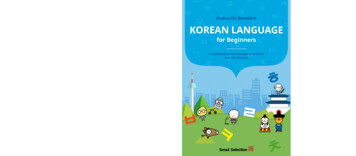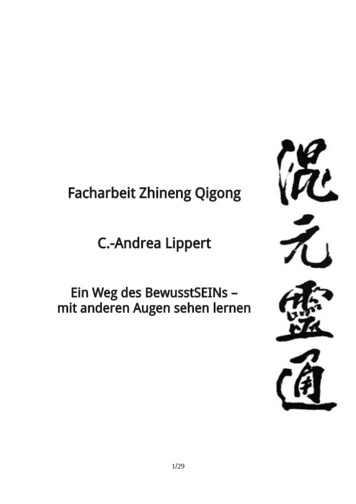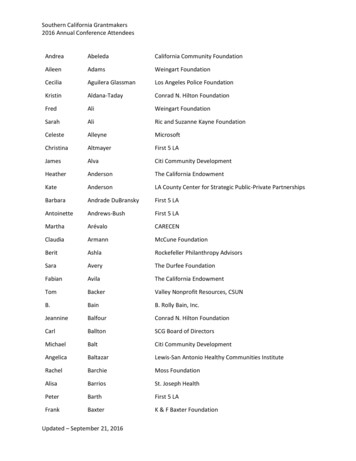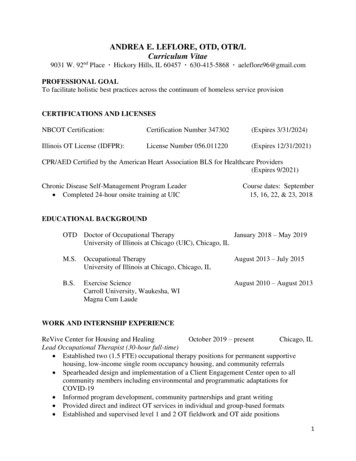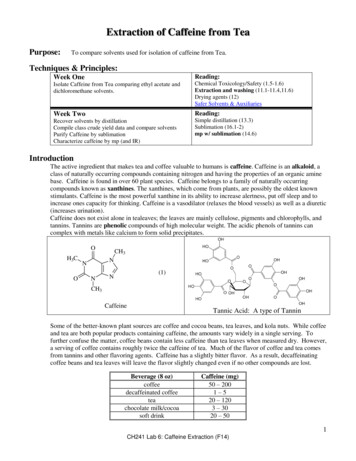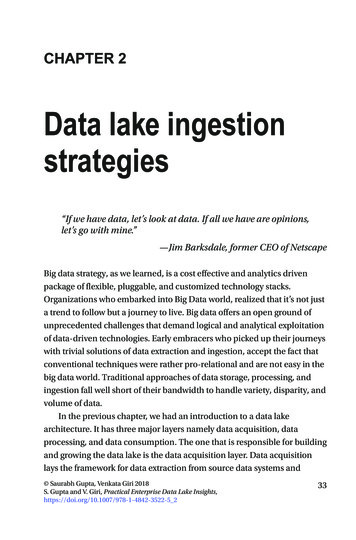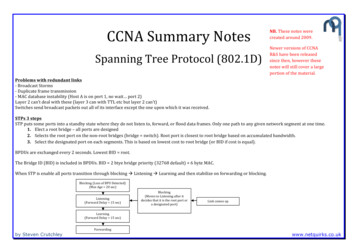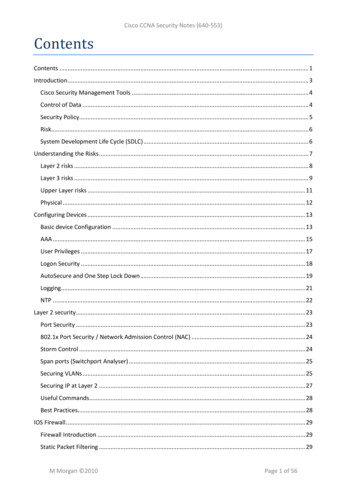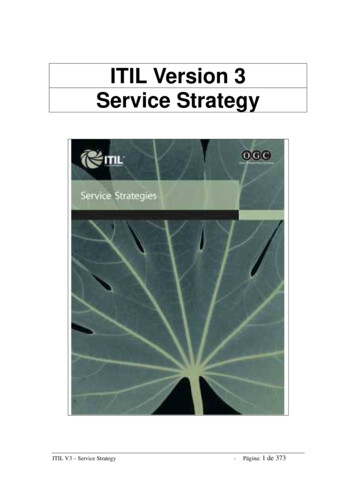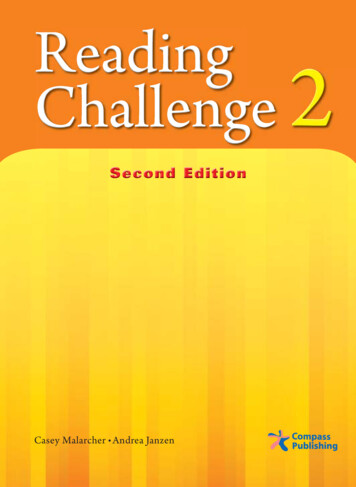
Transcription
Casey Malarcher Andrea Janzen
Reading Challenge 2 Second EditionCasey Malarcher · Andrea Janzen 2010 Compass PublishingAll rights reserved. No part of this book may be reproduced, stored in a retrievalsystem, or transmitted in any form or by any means, electronic, mechanical,photocopying, recording, or otherwise, without prior permission in writingfrom the publisher.Acquisitions Editor: Tamara GaskillContent Editor: Kelli RipattiCopy Editor: Joy CampbellCover/Interior Design: Design Plusemail: info@compasspub.comhttp://www.compasspub.comThe authors of this book would like to acknowledge the followingwriters for contributing materials to this series: Paul Edmunds,Barbara Graeber, Jennifer Janzen, Susan MacRae, Kristen Sinats,Michael Souza, Anne Taylor, Adam WorcesterISBN: 978-1-59966-530-612 11 10 9 8 7 6 5 4 3 2 114 13 12 11 10Photo Creditspp. 12, 24, 36, 38, 42, 59, 77, 78, 83, 84, 89, 90, 113, 114, 116, 122 iStock International Inc.pp. cover, 5, 8, 11, 14, 17, 20, 23, 35, 41, 50, 53, 56, 68, 71, 72, 74, 80, 86, 92, 95, 96, 98, 101, 104,107, 110 Shutterstock, Inc.pp. 26, 29, 30, 32, 44, 47, 60, 62, 66, 102, 119 ArtToday Inc.pp. 48, 54 National Archives and Records Administrationp. 65 Charles Parnellp. 108 Keirn O’Connorp. 120 Arthur PedrickEvery effort has been made to trace all sources of illustrations/photos/information inthis book, but if any have been inadvertently overlooked, the publisher will be pleasedto make the necessary arrangements at the first opportunity.
ContentsArts and Leisure1. In the Name of Beauty / 511. Shakespeare, Where Are You Now? / 65Culture and History2. Who Took That Tooth? / 1112. What’s in a Name? / 71Environment3. The Ring of Fire / 1713. Out of Rainforests / 77Health4. Myths About Pimples / 2314. For a Quick Pickup / 83Science Facts5. I Cut the Cheese! / 2915. The Misunderstood Tomato / 89People Profiles6. Mr. Nintendo / 3516. The Greatest of the Century / 95Social Science7. Are Sports Bad for Kids? / 4117. Rights of Lefties / 101Sports and Hobbies8. May I Have Your Autograph? / 47 18. The Snowy Slopes of Dubai / 107Technology9. Where Are Our Jetpacks? / 5319. Not All Hackers Are the Same / 113Weird and Bizarre10. Desert Delivery / 59Transcripts/ 12520. Weird Inventions / 119
In the Name of BeautyPre-ReadingThink about the following questions.Vocabulary Preview1. How often do you wear makeup?2. Do you think makeup is good or bad for the skin?Why?3. What did people use for makeup long ago?Write the letter of the word or phrase with the same meaning as theunderlined word.a. makes betterd. beliefs; normal waysb. tiny pieces of something solid e. small amounts of liquidc. very oldf. something that causes illness or death1. His new hairstyle really improves his looks.2. Young girls in that country often wear makeup. It’s part of that country’s culture.3. Sometimes I put powder on my face. Then it doesn’t look oily.4. Don’t touch that powder. It is a poison!5. She put a few drops of medicine in her eyes.6. Some ancient pictures in the pyramids show women wearing eye makeup.5
Track 1In the Name of BeautyCosmetics have been used throughout history. The ancient Greeks, the Egyptians,and the Romans all used various kinds of makeup. Some of these cosmetics wereused to improve one’s appearance. Others were used to protect one’s skin. However,in some cases, things used for makeup were dangerous or even deadly!Skin care treatments including perfumes, lotions, and cosmetic masks were usedin ancient Egypt by rich and poor alike. Egyptians also developed some of the earliestsunscreens. They used oils and creams for protection against the sun and dry winds.Egyptians, as well as other ancient cultures, used various powders on their skin forbeauty as well. Egyptians used black kohl around their eyes. Romans put white chalkon their faces. And Indians painted red henna on their bodies.Most of the ancient cosmetics were harmless. However, in the name of beauty, somepeople applied dangerous chemicals and poisons to their skin. During the ItalianRenaissance, women wore white powder made of lead on their faces. Of course, doctorstoday know lead is like a poison for our bodies. Also around the time of the Renaissance,women in Italy put drops of belladonna in their eyes. These belladonna drops were madefrom a plant whose poison affects the nerves in the body. By putting belladonna drops inher eyes, a woman’s pupils would become very large. People thought thismade women more beautiful. Actually, this is where the plant’s namecomes from. In Italian, belladonna means “beautiful woman.”When Elizabeth I was queen in the late 1500s, some ratherdangerous cosmetics were also being used by women in England.In particular, women were using special hair dye made withlead and sulphur. The dye was designed to give people red hair,the same color as the queen’s hair, but over time, the dyemade people’s hair fall out. Finally, women using this dyeended up bald, like the queen, and had to wear wigs.510152025Reading Time minutes seconds2cosmetics: makeup13lead: a soft metal (Pb)9kohl: a powder made of antimony sulfide (Sb2S3)used around the eyes15belladonna: a poisonous plant with black berries16chalk: a soft white limestone composed mostlyof the shells of small marine organismsnerve: the part of the body that passesinformation to the brain1710henna: a red or orange dye made from thehenna plantpupil: the hole in the middle of the eye thatcan become smaller or larger2213dye: a liquid for coloringRenaissance: the 1300s through 1500s inEurope, when great artistic and scientificachievements were made26wig: an artificial covering for the head thatlooks like hair96326 words
Reading ComprehensionChoose the best answer.1. What is the main idea of this reading?a.b.c.d.The ancient Egyptians used a lot of makeup.People have always used makeup.Some cosmetics in the past were dangerous.Italian women had the best makeup.2. Which of the following statements is NOT correct?a.b.c.d.The Egyptians used makeup to help their skin.The Romans used chalk to make their faces white.Queen Elizabeth I had blond hair.All of the above3. Where did Italian women apply lead powder?a. In their hairc. On their facesb. On their handsd. Under their arms4. What was belladonna used for?a. To give women pretty eyesc. To poison plantsb. To change the color of women’s skind. To make people look smarter5. What is the meaning of “rather” as it is used in line 20?a. normallyc. preferredb. on the contraryd. fairlyIdiomatic ExpressionsFind these idioms in the reading. in some cases[ sometimes ]In some cases, the medicine made people’s hair fall out. in the name of[ for ]The explorer claimed the island in the name of his country. end up[ to finally become ]She started her own company and ended up a millionaire.Fill in the blank with one of the above idioms. Change its form if necessary.1. , teachers found students did better on longer exams.2. Let’s follow the map, or we may lost.3. We must keep fighting freedom!7
SummaryFill in the blanks with the correct words.in the name e been used all throughout history, not all ofthem have been safe. In fact, some of them have been quite 2 to people., people thought women with bigFor example, long ago in Italian3eyes were beautiful. Therefore,beauty, women began to put45of belladonna in their eyes to make their pupilslarger. Belladonna, however, is poisonous, and it canaffect the 6 in the body.ListeningMakeup for Men?Track 2Listen to the dialog and choose the best answer.1. Which is true about the man?a. He doesn’t usually wear makeup.c. He does not have good skin.b. He works for a cosmetics company.d. He knows a good place to buy makeup.2. According to the woman, why do a lot of men wear skin creams?a. It makes their skin white.c. It smells nice.b. It is fun.d. It protects their skin.3. What happens at the end of the conversation?a. The man puts on a cosmetic.c. The woman buys the makeup.8b. The man gets angry.d. The man promises to help the woman.
DiscussionDiscuss the following questions.1. Which brands of makeup are good for your skin?2. What is the strangest beauty treatment you have heard of?3. What do you wear when you want to look nice?GrammarInfinitives of PurposeAn infinitive can be used to talk about a person’s purpose as a reduced form of in order toor so as to.Some of these cosmetics were used (to improve / to improving) one’s appearance.The dye was designed (to give / to giving) people red hair, the same color as the queen’s hair.WritinggWrite your own short paragraph by answering the questions below.Dressing upExample(1) What do you wear to dress up?(2) What are those things made of?(3) What color are those things?OR How do those things look? (4)When was the last time you worethem? (5) Did anyone notice or sayanything about how you looked?I wear a suit and tie to dress up.I don’t know what my suit is madeof, but my tie is made of silk. Mysuit is dark blue, and my tie is redand yellow. The last time I worethem was at my sister’s wedding.Nobody noticed me because most ofthe men at the wedding were insuits.9
Vocabulary and Idiom ReviewA. Choose the best word or phrase to fill in the blank.1. Creams can make our skin .a. ancientb. largec. poord. smoothc. treatmentd. wig2. I think it will rain soon. I just felt a .a. dropb. plant3. If you need perfume, you should go to a store that sells .a. skinb. cosmeticsc. historyd. prices4. Joan of Arc tried to lead her army to fight God.a. ending upb. having to doc. in some cases d. in the name of5. She sat on the beach all day. Now her is red.a. powderb. culturec. pupild. skinc. oild. powder6. That is not dust on the floor. It is face .a. dyeb. cream7. Be careful. Some of those chemicals are .a. ancientb. dangerousc. silkyd. specialB. Choose the correct form of the word to fill in the blank.8. The people living in the rainforest hunt with arrows.a. poisonb. poisonousc. poisoning9. The country is unique. There is no other culture like it.a. cultureb. culturalc. culturally10. The new and soap seems very similar to the old soap.a. improvement10b. improvesc. improved
Who Took That Tooth?Pre-ReadingThink about the following questions.Vocabulary Preview1. Do you remember losing your teeth as a child?How did it happen?2. What did you do with your baby teeth? Did youkeep them?3. What do people in other countries do with theirbaby teeth?Write the letter of the word or phrase with the same meaning as theunderlined word or phrase.a. has the duty ofb. specific; accuratec. think highly ofd. think of; believee. rather than; in the place off. usual thing to do by tradition1. It is a custom for children to put lost teeth under their pillows.2. A bird is responsible for taking the lost tooth away.3. People in Mongolia respect dogs a lot, so they take good care of them.4. Koreans consider one kind of bird very lucky.5. She hopes to get money instead of a gift.6. This is the exact place where I put the lost tooth last night.11
Track 3Who Took That Tooth?Different cultures follow their own special customs when a child’s baby teeth fallout. In Korea, for example, they have the custom of throwing lost teeth up on theroof of a house. According to tradition, a magpie will come and take the tooth.Later, the magpie will return with a new tooth for the child. In other Asian countries,such as Japan and Vietnam, children follow a similar tradition of throwing lost teethonto the roofs of houses.Birds aren’t the only animals thought to take lost teeth. In Mexico and Spain,tradition says a mouse takes a lost tooth and leaves some money. However, in Mongolia,instead of mice, dogs are responsible for taking teeth away. Dogs are highly respectedin Mongolian culture and are considered guardian angels of the people. Tradition saysthat the new tooth will grow in good and strong if the baby tooth is fed to a guardianangel. Accordingly, parents in Mongolia will put their child’s lost tooth in the fat of apiece of meat and feed it to a dog.The idea of giving lost teeth to an angel or fairy is also a tradition in the West. Manychildren in Western countries count on the Tooth Fairy to leave money or presents inexchange for a tooth. The exact origins of the Tooth Fairy are a mystery, although thestory probably began in England or Ireland centuries ago.According to tradition, a child puts a lost tooth under his orher pillow before going to bed. In the wee hours, while thechild is sleeping, the Tooth Fairy takes the tooth and leavessomething else under the pillow. In France, the Tooth Fairyleaves a small gift or candy. In the United States, however, theTooth Fairy usually leaves money. These days, the rate is 1 to 5 per tooth. That can add up to a lot of money from the ToothFairy!510152025Reading Time minutes seconds12324 words3roof: the top or covering over a house15Western: related to Europe and North America3magpie: a black and white bird15present: a gift10guardian angel: a spirit protecting a person16exchange: trade12fat: the part of meat with a lot of oil17century: a hundred years14fairy: a tiny mythical creature with magicalpowers19pillow: a soft thing to support one’s head
Reading ComprehensionChoose the best answer.1. What is the main idea of this reading?a.b.c.d.The Tooth Fairy leaves money for teeth.Different cultures have different traditions about teeth.Many Asian countries have similar traditions concerning teeth.Some tooth customs involve animals.2. Why do some people throw a tooth on the roof?a. To get richc. To have a long lifeb. To get a larger housed. To get a new tooth3. Where did the story of the Tooth Fairy probably come from?a. North Americac. Western Africab. Eastern Asiad. Northern Europe4. What is NOT traditionally put under a pillow in exchange for a tooth?a. A new toothc. A giftb. Moneyd. Candy5. Which meaning can define “lost” as used in line 7?a. Misplacedc. Wastedb. Not wond. Fallen outIdiomatic ExpressionsFind these idioms in the reading. count on[ to expect; to rely on ]I counted on you to help me, but you disappointed me. the wee hours[ between midnight and 4:00 or 5:00 a.m. ]Because I drank coffee, I couldn’t get to sleep until the weehours of the morning. add up[ to make sense; to equal ]Two and two adds up to four.Fill in the blank with one of the above idioms. Change its form if necessary.1. All of the results we found in the experiment don’t .2. I’m your friend. You can always me.3. The house was completely still and quiet during .131
SummaryScan the passage and complete the chart with the correct information.fairyand leaves a giftand leaves moneyMongoliaWhere Asian countriesbirdtakes the toothWho 1What Throw teeth on the rooffor it. Mexico/Spain Mouse It takes the tooth2. 3 Dog It eats the tooth. France 4 It takes the tooth5 United States Fairy. It 6 andleaves money.ListeningTooth Traditions in NigeriaTrack 4Listen to the dialog and complete each sentence.1. The man explains a custom about teeth in .2. If a person is a baby’s first tooth, he or she has to give thechild a gift.3. The gift should be something like .14
DiscussionDiscuss the following questions.1. What did you or your parents do with your baby teeth?2. Would you prefer to keep your baby teeth or follow your culture’s custom aboutteeth?3. What is a special custom that your parents followed while you were growing up?GrammarTransitive VerbsA transitive verb takes a direct object, which can be a noun, a pronoun, a phrase, or a clause.Different cultures (follow / follow after) their own special customs when a child’s baby teeth fall out.In France, the Tooth Fairy (leaves / leaves after) a small gift or candy.WritinggWrite your own short paragraph by answering the questions below.A Custom in My FamilyExample(1) What is a custom your familyfollowed? (2) When did your familydo this? (3) What did your familydo? (4) How did that custom makeyou feel? (5) Will you follow thatcustom with your children?My family followed the customof sending each child on a tripalone. My parents sent each of uson a trip when we were sevenyears old. They sent us to stay forone week with my grandmotherin another state. I really enjoyedthis time with my grandmother. Ihope to follow this custom withmy own children someday.15
Vocabulary and Idiom ReviewA. Choose the best word or phrase to fill in the blank.1. Do you think we can the package arriving tomorrow?a. add upb. count onc. fill outd. end up2. I think it is a good to take your shoes off in the house.a. customb. fairyc. mysteryd. pillow3. People have been following that tradition for centuries.a. ancientb. newc. lostd. strong4. Please put the sauce on the side on top of the chicken.a. according tob. althoughc. instead ofd. usually5. The new computer program works much better. The company the programa lot.a. consideredb. includedc. improvedd. respected6. There are many other of art other than just painting and sculpture.a. centuriesb. formsc. originsd. presents7. You cannot that shirt if you don’t have the receipt.a. considerb. encouragec. exchanged. respectB. Choose the correct form of the word to fill in the blank.8. No one knows where Joe lives.a. exactb. exactlyc. exactness9. The plane disappeared over the Pacific Ocean.a. mysteryb. mysteriousc. mysteriously10. You should the beliefs of others even if you disagree with them.a. respect16b. respectedc. respectful
The Ring of FirePre-ReadingThink about the following questions.Vocabulary Preview1. What causes earthquakes?2. How are volcanoes formed?3. Does the ground move even when there are noearthquakes?Write the letter of the word or phrase with the same meaning as theunderlined word or phrase.a. oftenb. is made ofc. top; coveringd. goes upe. idea; assumed law in sciencef. steps toward achieving some result1. Earthquakes frequently occur in Japan.2. Scientists did not prove the theory yet, so many people don’t believe it.3. One idea says the surface of the Earth is covered by huge plates of land.4. Lava rises from under the Earth and comes out of volcanoes.5. The process of creating new land involves lava becoming solid rock.6. Lava consists of various kinds of rock melted together.17
Track 5The Ring of FireThe Ring of Fire is an enormous chain of volcanoes all around the Pacific Ocean.The ring goes from New Zealand up to Asia and across the ocean to Alaska. FromAlaska, the ring continues southward along the coast of both North and SouthAmerica. More than seventy-five percent of the world’s volcanoes are located in thisring.Scientists are interested in studying the Ring of Fire because they can observeplate tectonics at work there. In 1912, a German scientist, Alfred Wegener, came up withthe first theory of land movement. Wegener said continents are made up of lighterrocks resting on heavier material. Similar to the way large things move while floatingon water, Wegener suggested that the positions of the continents were not fixed, butthat they moved slightly. Later, scientists discovered most of Wegener’s ideas wereright on the mark. They then developed the theory called plate tectonics.According to plate tectonics, the surface of the Earth consists of a number ofenormous plates or sections of rock, each about eighty kilometers thick. The platesfloat and slowly move at speeds between one to ten centimeters every year. That isabout the rate your fingernails grow! Within the Ring of Fire, new material for theEarth’s plates is constantly being created as hot liquid rock called magma flows fromthe center of the Earth up to the ocean floor. All the existing plates on the Earth’s surfacehave to move slightly to make room for the new material.As plates move both away from and towardeach other, they run into each other. When they hiteach other, one plate might move under another.This process is called subduction. Subductionfrequently causes earthquakes. It may also resultin the bottom plate melting due to the extremetemperatures under the top plate. The magmacreated in this process can rise to the Earth’ssurface and come out through volcanoes, as canbe seen along the Ring of Fire.510152025Reading Time minutes seconds1ring: a circle11slightly: a little; to a small degree or extent1chain: a connected series of things14section: a part that is cut off or separated3southward: in the direction of south15float: to stay on the surface of a liquid8continent: a large area of land including manycountries, like Asia, Europe, Africa, etc.16rate: the speed17flow: to move like liquidmaterial: what something is made of25melt: to become liquid918333 words
Reading ComprehensionChoose the best answer.1. What is the main focus of this reading?a. The most active volcanoes found in the Ring of Fireb. The location of the Ring of Firec. How the plates on the Earth’s surface move in different waysd. How plate tectonics, volcanoes, and earthquakes are related2. According to the reading, which is true about the Ring of Fire?a. All of the volcanoes along the ring are active.b. Most of the volcanoes on Earth are part of the ring.c. The ring gets bigger each year.d. The ring was discovered in the 20th century.3. What does “subduction” mean in this reading?a. Rocks moving under volcanoesb. Erupting liquid rockc. The theory of moving platesd. Movement of a plate under another4. What is NOT a result of shifting tectonic plates?a. Earthquakesb. Extreme temperatures inside the Earthc. Volcanoesd. Subduction5. Which question is NOT answered in the reading?a. How fast do tectonic plates move?b. How thick are the plates in tectonic theory?c. What is the most active volcano today?d. Where is the Ring of Fire?Idiomatic ExpressionsFind these idioms in the reading. come up with[ to think of first; to have an original idea ]I hope the politicians can come up with a way to avoid war. right on the mark[ exactly correct ]The advice you gave me for fixing my essay was right on the mark. run into[ to hit or bump; to meet by chance ]I ran into an old friend yesterday on my way to work.Fill in the blank with one of the above idioms. Change its form if necessary.1. I finally a good topic for my essay.2. She frequently tries to guess people’s age, and most of the time she’s .3. It’s important to drive carefully so you don’t anything.191
SummaryRead the sentences from the reading passage. Paraphrase the sentencesto create a summary of the passage.a. The Ring of Fire is an enormous chain of volcanoes all around the PacificOcean.b. More than seventy-five percent of the world’s volcanoes are located in thisring.1. a b: Around the Pacific Ocean is a chain of volcanoes called the Ring of Fire,in which .c. According to plate tectonics, the surface of the Earth consists of a numberof enormous plates or sections of rock, each about eighty kilometers thick.d. The plates float and slowly move at speeds between one to ten centimetersevery year.2. c d: Movement of sections of the Earth’s surface is explained by the theoryof plate tectonics, according to which .e. When they hit each other, one plate might move under another.f. This process is called subduction.3. e f: During the process of subduction, .ListeningMore Interesting FactsTrack 6Listen to the dialog. Check True or False for each sentence.1. Mt. Fuji is the tallest volcano in the world.2. Mauna Loa erupted over thirty times last year.3. Kilauea has been continuously erupting since the 1980s.20TrueFalse
DiscussionDiscuss the following questions.1. Have you ever seen a volcano erupt? Would you like to?2. Have you ever experienced an earthquake? If yes, describe your experience.3. Which of these events was most recently in the new: a volcanic eruption or anearthquake? Where was it and what happened?GrammarAdverbial Phrases and Adverbial ClausesAn adverbial phrase does not include a subject and a verb, while an adverbial clause includesa subject and a verb. Both should be followed by a comma at the start of a sentence.(According to / According as) plate tectonics, the surface of the Earth consists of a number ofenormous plates or sections of rock, each about eighty kilometers thick.(Because of / As) plates move both away from and toward each other, they run into each other.WritinggWrite your own short paragraph by answering the questions below.A Recent EventExample(1) What recent natural disasterhappened? (2) How did you hearabout it? (3) Where and when didit happen? (4) What damage wasdone? (5) What happened after thedisaster?A recent natural disaster wasa hurricane. I heard about thehurricane on television. Thehurricane hit Florida last spring.Lots of houses fell down, butnobody died. After the hurricane,people fixed their houses and lifewent back to normal.21
Vocabulary and Idiom ReviewA. Choose the best word or phrase to fill in the blank.1. Because of the heavy rain, the water level of the river is .a. absorbingb. floatingc. movingd. risingc. ringd. surface2. The of the lake was very calm.a. dropb. plate3. This problem is difficult, but I need to the answer.a. exchangeb. figure outc. flowd. slide4. Please help me with this math problem. I can’t the answer.a. end upb. face up toc. come up with d. run into5. The book describes the of events that started World War II.a. chainb. culturec. processd. rate6. Walking to work instead of driving every day has my health.a. improvedb. locatedc. releasedd. touched7. The class students from many different countries.a. consists ofb. hangs aroundc. is right ond. slightly movesB. Choose the correct form of the word to fill in the blank.8. According to scientific , the universe began several billion years ago.a. theoryb. theorizec. theoretical9. He decided not to buy the vase because it had a crack.a. slightb. slightlyc. slightest10. The manager asks members of our team to work overtime.a. frequency22b. frequentc. frequently
Myths About PimplesPre-ReadingThink about the following questions.Vocabulary Preview1. Has anyone ever given you advice on how totake care of your skin?2. What are some things that are bad for your skin?3. What should people do to get rid of skinproblems?Write the letter of the word or phrase with the same meaning as theunderlined word.a. definitely; surelyb. kind; sortc. untrue story or beliefd. disease caused by germse. make a problem worsef. urge1. People say strong soap helps your skin, but that is a myth.2. She did not wash her finger after she cut it, so she got an infection.3. Don’t scratch your rash. You will irritate it.4. I encourage you to stop eating candy and sweet snacks.5. Pimples are only one form of skin problem.6. Pimples are not necessarily a sign of dirty skin.23
Track 7Myths About PimplesAlmost everybody has had acne. Acne, also known as pimples or zits, is a normalpart of growing up. When kids reach puberty, their bodies experience manychanges. As the levels of hormones in teenagers’ bodies change, teenagersfrequently develop pimples. Additionally, many people continue to have pimples afterpuberty. What can a teenager or an adult do to cure pimples? Unfortunately, manycures people think will work on pimples are really just myths.Many people believe that popping pimples is the best way to get rid of them.Popping a pimple will actually push the germs further under the skin, which can causemore redness and pain, or even turn into an infection. For that reason, doctors whospecialize in skin problems normally encourage people not to pop their pimples.Also, do you think that washing your face frequently will help get rid of pimples?Of course, washing your face is a good idea, but washing your face too much couldirritate the skin more, making the pimples even worse.Another widely believed myth is that not wearing makeup canhelp reduce a person’s chance of developing pimples. In fact, somekinds of makeup or face creams actually have special medicine inthem to fight pimples. As a result, not all of them are bad for you.Along with makeup, people claim that eating fatty foods orchocolate can cause acne. The truth is that eating a candy bar or apiece of pizza will not cause pimples. Even so, both teenagers andadults should still try to eat foods that are good for their bodies andtheir skin.Another myth is that stress can cause acne. Stress comes inmany forms, like a big exam at school or problems with friends. Whileit is true that stress can cause a person’s skin to create extra oil, thisextra oil does not necessarily cause more pimples.510152025Reading Time minutes seconds1acne: a medical term for pimples5cure: to fix or solve a health problem1pimple: a red spot of infection on the skin7pop: to break; to burst1zit: a slang word for a pimple82puberty: the teenage years when the bodychangesgerm: a very small organism that causesdiseases324318 wordshormone: a chemical produced in the body18fatty food: a food with a lot of fat in it
Reading ComprehensionChoose the best answer.1. What is the main idea of this reading?a. In the past, people thought pimples showed a serious disease.b. People do many things to cure pimples which don’t actually work.c. Pimples are not a problem for most people.d.
and the Romans all used various kinds of makeup. Some of these cosmetics were used to improve one’s appearance. Others were used to protect one’s skin. However, in some cases, things used for makeup were dangerous or even deadly! Skin care treatments including perfumes, lotions, and cosme
